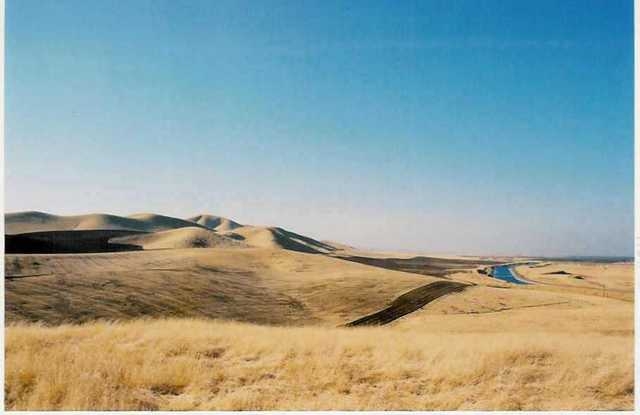Posts Tagged: livestock
California's dry winter is leaving west side cattle hungry
The long rainless winter resulted in grass growth on the west side of the San Joaquin Valley about 80 percent less than usual, reported John Holland in the Modesto Bee. Spring rain pushed somewhat more growth on the valley's east side, which was charted at 55 to 70 percent less than normal.
Theresa Becchetti, UC Cooperative Extension advisor in Stanislaus and San Joaquin counties, a livestock expert, and Diana Waller, district conservationist for the U.S. Natural Resources Conservation Service, reported the conditions in a letter last month to county and federal agriculture officials.
Fall 2011 rain helped germinate seeds, but "unfortunately, that is where it ended," they wrote.
A cattle producer quoted in the story said the poor feed conditions are offset somewhat by beef prices that have remained strong.

The USDA reported that nonirrigated range condition was poor to fair, with some higher-elevation range in good to fair condition.
Not a lot of greenhouse gas is from animal ag
There's been some confusion in recent years about the impact of animal agriculture on global warming. UC Davis Cooperative Extension air quality specialist Frank Mitloehner will share his findings on the subject this month during a free webinar on the eXtension website, according to an article in Pork magazine.
The 2006 United Nations report "Livestock's Long Shadow" said the livestock sector is responsible for 18 percent of greenhouse gas emissions, a higher share than transportation. Mitloehner said livestock's contribution is more like 3 percent, yet wide distribution of the misinformation has put Americans and others on the wrong path toward solutions.
The webinar, which will include information from Mithoehner's report "Clearing the Air: Livestock's Contribution to Climate Change," is at 11:30 a.m. Pacific Time June 11. Forum participants will have the opportunity to ask questions, post comments, upload photos and share their experiences. All the details, including links to background information and to the webinar, are in this eXtension flyer.

Black and white swine.
Animal feed generates lots of valley ozone
Scientists have been puzzled by the fact that the San Joaquin Valley often suffers high ozone levels even though the mostly rural, agricultural domain has fewer cars and trucks than big cities. Research by UC Davis scientists is now showing that some of the ozone in the valley is being generated by fermented animal feed, according to a story posted yesterday on the website Science News.
While ozone provides a protective barrier for the earth in the stratosphere, it is an unwelcome molecule to have around where people are breathing. Ozone (O3) is a powerful oxidizing agent, far stronger than O2. It can harm lung function and irritate the respiratory system.
The UC Davis team, led by environmental engineer Cody Howard, tested seven types of animal feed in a one-meter-square tented chamber, according to writer Janet Raloff, author of the Science News story. They added a mix of gases that matched the valley’s air and simulated sunlight with lamps. The result was lots of ozone.
Corn silage generated about 125 parts per billion ozone, alfalfa silage a little less, and mixed oat-wheat silage 210 ppb, Raloff reported. These emissions pale in comparison to cars. However, because the San Joaquin Valley has so much silage to feed its animal agriculture industry, the feed appears to be the single biggest contributor to the region’s ozone problem, the story said.
Cars and light-duty trucks in the valley can generate 13 metric tons of ozone per day, while feed for the valley’s 10 million head of dairy cattle can produce 24.5 million tons of ozone per day.

Corn silage livestock feed.
When will Mother Nature get it right?
Farmers reeling from three years of drought and an unseasonably warm January are now worried about rainfall at the wrong time of year, according to a story in today's Redding Record Searchlight.
Almond trees that bloomed early because of warm January weather suffered some frost damage. Now, rain during spring bloom is inhibiting pollination. (Who can blame bees for curling up with a good book on rainy days?) Wet weather also raises concerns about fungal diseases. But despite these abnormal weather patterns, UC Cooperative Extension farm advisor Bill Krueger assured writer Debra Moore that almond farmers will still have nuts to harvest next fall.
"If there is good weather between storms, it will give the bees a chance to pollinate," Krueger was quoted. "The diseases won't be as bad as they would have been had these been warm storms."
The article also covered problems experienced by cattle ranchers when precipitation doesn't arrive on schedule.
UCCE livestock program representative Josh Davy told the reporter that February rain storms are filling up stock water ponds, but won't help farmers concerned about this season's rangeland vegetation, on which they rely for animal rations.
"The annual grasses are germinated with fall rains," Davy was quoted. "And this rain has come too late."
